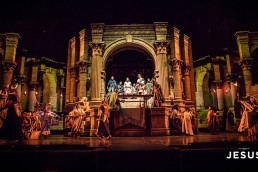This website uses cookies so that we can provide you with the best user experience possible. Cookie information is stored in your browser and performs functions such as recognising you when you return to our website and helping our team to understand which sections of the website you find most interesting and useful.
EMEA & APAC AWARDS • THE AMERICAS AWARDS
Sight & Sound Theatres
ProjectSight & Sound TheatresLocationPennsylvania & Missouri ManufacturersOutboard, QSC, Clair Brothers, EAWAcousticianGary ParkeSubmitted byOutboard
For over 40 years, Sight & Sound Theatres have been bringing the bible to life for the American public through their live and epic-scale biblical productions. A unique aspect of the organisation is that their lavish productions are staged sequentially at two identical venues, based in Lancaster, Pennsylvania and Branson. Missouri. In both theatres an extra layer of vitality and sentience has been added to the storytelling with the introduction of TiMax spatial reinforcement and immersive audio.
Gary Parke, audio integrator for Sight & Sound, first evaluated the capabilities of TiMax on a production in the primary venue located in Lancaster, PA. The 2000-capacity theatre features a vast 92-metre wraparound stage and TiMax proved itself an invaluable remedial and creative tool.
Sight & Sound’s productions are developed on a huge scale. Unsurprisingly and to gain maximum value, every production that premieres at the Lancaster venue is also designed to travel to its sister theatre in Branson, Missouri to run the following season.
The audio system at the Missouri venue is as far as possible a duplicated version of the first venue. This ensures show audio content and programming files can be sent on ready to mount the new production to ensure the simplest show transfer. For this reason, Sight & Sound invested in a second TiMax SoundHub-S64 for the Branson venue.
Sight & Sound invested in a TiMax TrackerD4 performer tracking system first for the Pennsylvania venue, and soon afterwards into Missouri.
Extra credibility and enhancement are injected into the show’s shifting mise-en-scene with fully enveloping 3D ambience effects, with playback from both QLab and TiMax dynamically spatialised by TiMax with cues triggered from timecode.
Parke explains, “The timeline features and controlling the image definitions for our actors is a big benefit. TiMax has given us much greater flexibility in localising the actors’ mics in relation to their stage zones. The timecode triggered cues on TiMax move the different mic groups or channels to the different zones as the actors move around the stage.”
Typically, up to seventy channels of wireless microphones worn by the actors are fed via Dante from a Studer Vista console to the 64-channel TiMax SoundHub, either direct or as groups. TiMax Cues dynamically morph them between spatial image definition objects via the distributed house sound system, comprised of four hangs of QSC Wideline 10 with four Clair Brothers C8-i line arrays for the side surrounds and a further 27 full range speakers for overheads. Sub support is provided by a central cardioid array centre house of eight Clair CS218s with four EAW SB1000s positioned front on the stage floor. Fill for the front and side stages is delivered via 26 EAW JF80s with six EAW full range speakers managing the rear surround on the main floor with a further four full range speakers attending to the raised seating area.
Speaking about the overall integration of TiMax into the production audio, Parke says, “It’s been a very positive. We’ve found the ease of programming and flexibility were a big benefit to using TiMax. The timeline is fantastic with a visual overview of the show programming; it makes it much easier to program the show.”



